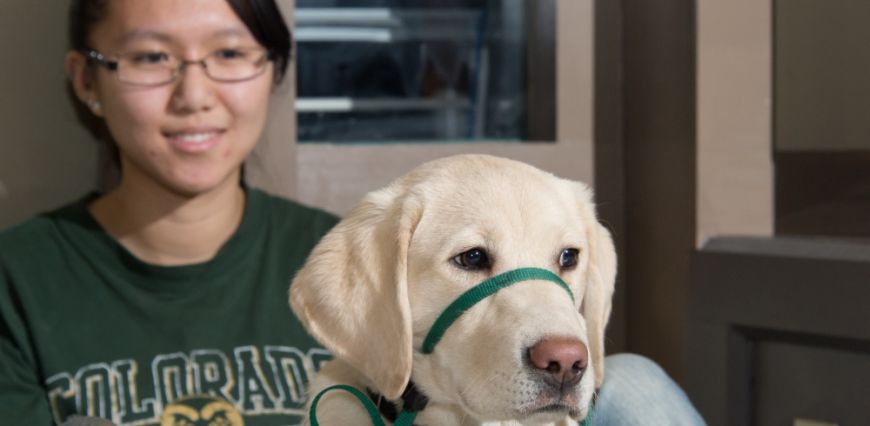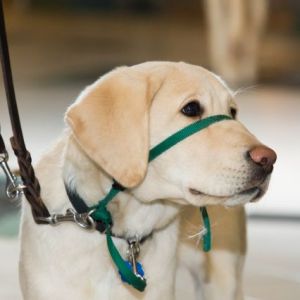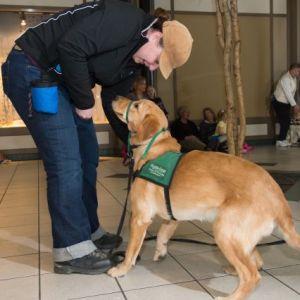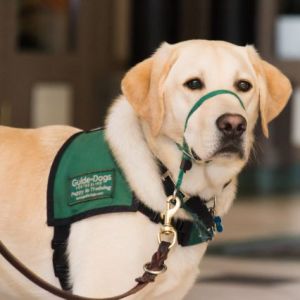
Walk around the Colorado State University campus during National Service Dog Month in October – or any time during the academic year – and you’ll likely see a student and four-legged companion on the “ruff” and rewarding training journey to prepare the pup as a Guide Dog for the Blind.

“Service animals do so much to enhance and save lives,” said Toni Eames, president of International Association of Assistance Dog Partners, who spoke to a group of CSU veterinary students this semester. “It’s an intense, 24/7 relationship.”
That relationship is built on the trust that comes with a service dog’s training and upbringing – beginning when a puppy is just 8 weeks old.
“My dog is trained to save me,” Eames said, referring to her own vision impairment. “I know that my animal is there to enhance my disability.”
A 24-hour job
Before entering formal Guide Dogs for the Blind training, puppies work with volunteers for about one year, learning good manners and basic obedience. Volunteers also must socialize the puppies, making them comfortable and focused in any situation.
“It’s a ton of work. They are with you 24 hours a day, so you have to train them quickly to be calm and avoid wrestling around and whining – especially in classrooms,” said Alexis Ward, a CSU senior majoring in dance, who once was kicked out of a class for her puppy’s distracting behavior.

“But it’s all worth it to see how a puppy can transform into a working dog that is helping someone by being their eyes and their companion,” Ward said.
Guide Dogs for the Blind Puppy Raising programs are located in nine states: Arizona, California, Colorado, Idaho, Nevada, Oregon, Texas, Utah and Washington. At any given time, Larimer Club (TLC) in Fort Collins, a local chapter of Guide Dogs for the Blind, has about 12 puppies in training and several CSU student volunteers.
“We recruit a lot of our CSU volunteers by word-of-mouth. They typically see another student walking around campus with a little puppy with a green vest and approach them,” said Fred Sprague, the Larimer Club (TLC) Guide Dogs for the Blind volunteer leader.
The club hosts weekly meetings that bring together puppies of all ages to train. Students involved said puppy training can be nerve-racking.
“At first I was so afraid I was going to do something wrong. It was to the point where I just wanted the dog to sit and not do anything,” said Amanda Hitpas, a CSU senior business major.
Ward, who has raised four dogs, said each experience is different. “Each time I get a new puppy, I’m starting from square one and have to learn how the new puppy learns and responds to me,” she said.
“Lab” experience

Puppy trainers, called “raisers,” keep constant watch on dog interactions with objects, animals and people. This includes educating the public about how to interact with a puppy in training.
“When you have a cute guide-dog puppy, you have to be willing to talk to people comfortably about what you are doing, and encourage them to respect that the puppy is at work,” said third-year CSU veterinary student Jennie Dragan, who has raised three puppies.
Dragan promotes TLC through in-class presentations in the College of Veterinary Medicine and Biomedical Sciences and CSU Pre-Vet Club meetings.
“I now understand every animal has a distinct personality that requires a different approach to gaining that animal’s trust,” Dragan said. “Hopefully, I can keep this in mind as a veterinarian caring for different animals with different personalities.”
Dragan and Hitpas said they have gained valuable communication and animal-handling skills that will benefit them in their careers working with both animals and people.
“Being a pre-veterinary student, I was looking for volunteer opportunities that would allow me to work with animals and gain experience with human interactions as well,” Hitpas said. “I’ve learned more than I ever expected, and I can’t wait to apply these skills in a career as a veterinarian or just in life itself.”